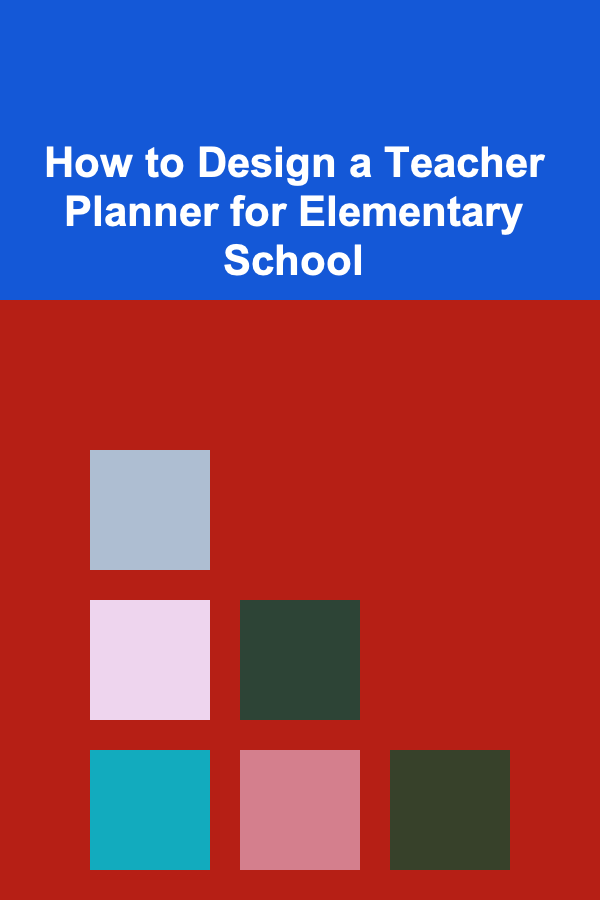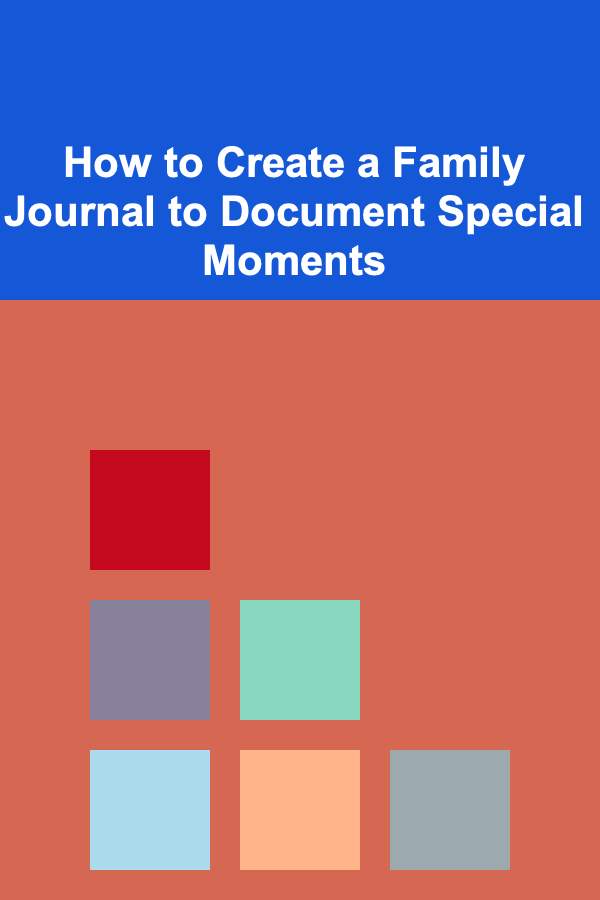
How to Design a Teacher Planner for Elementary School
ebook include PDF & Audio bundle (Micro Guide)
$12.99$5.99
Limited Time Offer! Order within the next:

Designing an effective teacher planner for elementary school requires understanding the unique needs of both the teacher and the students. A good teacher planner is more than just a tool for keeping track of lessons and schedules---it is a comprehensive guide that helps teachers stay organized, manage their time efficiently, and meet the educational needs of their students. This article will explore how to design a teacher planner for elementary school that is not only functional but also easy to use, flexible, and supportive of the teacher's goals and responsibilities.
Why an Effective Teacher Planner is Crucial for Elementary School Teachers
Elementary school teachers juggle a wide variety of responsibilities on a daily basis. From lesson planning to classroom management, parent communication, and extra-curricular activities, a teacher's workload is both diverse and demanding. An effective teacher planner serves as a vital tool to manage these duties and create an organized structure for each school day, week, and month.
Key Benefits of a Teacher Planner:
- Time Management: A well-designed planner helps teachers stay on top of their daily tasks, ensuring that all aspects of their role are given adequate attention.
- Goal Setting: A planner allows teachers to set clear, measurable goals for their students and track progress.
- Student Needs: It offers a space to record important information about each student, including special needs, learning styles, and individual progress.
- Parent Communication: A planner provides an area to keep track of important messages and meetings with parents.
- Reduced Stress: By organizing their schedules and tasks, teachers can reduce stress and ensure a smoother workflow.
Essential Features of a Teacher Planner for Elementary School
1. Monthly and Weekly Layouts
The backbone of any teacher planner is the ability to plan both on a monthly and weekly basis. This allows teachers to have a bird's-eye view of upcoming events and daily tasks.
- Monthly Overview: The monthly section should have enough space to write key dates such as holidays, school events, parent-teacher conferences, and important deadlines. Teachers can also use this space to plan long-term projects or milestones for the class.
- Weekly Planner: The weekly planner should break down each day into smaller sections where teachers can schedule lessons, activities, and administrative tasks. A typical elementary school teacher's day may need to account for different subjects, such as math, reading, science, and social studies. The weekly layout must allow for flexibility, as daily schedules often change due to unexpected events or needs.
2. Lesson Plan Section
An essential aspect of the teacher planner is the lesson planning section. The teacher's primary responsibility is to educate their students, and having a clear and structured lesson plan for each subject area is essential.
- Subject-Specific Templates: Organize the lesson plan section by subject area or class. Each subject should have its own dedicated space with sections for objectives, materials needed, lesson activities, assessments, and any modifications for students with special needs.
- Weekly Breakdown: The lesson plan section should allow teachers to write detailed plans for each week, with space to record daily lesson objectives, activities, and assessments. This ensures that the teacher remains on track and can easily refer to what has been taught and what still needs to be covered.
- Space for Reflection: It's also beneficial to include a section at the end of each week or month for teacher reflections. This section could include notes on what worked well, what could be improved, and ideas for future lessons. Reflection helps teachers refine their methods and continually improve.
3. Student Roster and Data Tracking
A teacher planner should include a section for keeping track of student data. This includes attendance, grades, and any relevant behavioral or academic notes.
- Student Information: This section should include space for each student's name, grade level, special needs, and any other important notes, such as allergies or individual learning styles.
- Progress Tracking: Space to record individual student progress, such as assessment results, personal milestones, or behavioral observations. Teachers can use this to monitor academic progress over time and identify areas where a student may need additional support.
- Attendance Log: An easy-to-use system for tracking student attendance helps ensure that teachers remain aware of any absences, tardies, or important notes related to student attendance.
4. Classroom Management Tools
Classroom management is an ongoing responsibility for teachers, and a planner can provide tools to keep track of this aspect of teaching.
- Behavioral Tracking: Many elementary school teachers deal with a wide range of behavioral issues in their classrooms. A section dedicated to tracking student behavior allows teachers to note patterns, reward good behavior, or address concerns before they become larger problems.
- Seating Charts: Teachers can include space for seating arrangements, which is critical for organizing the class and managing group dynamics. Additionally, it can be helpful to make note of any seating changes that work or don't work for students.
- Rules and Procedures: The planner should also have space for teachers to write and reinforce classroom rules, procedures, and routines. This section acts as a reference guide for maintaining order and consistency in the classroom.
5. Parent Communication Logs
Effective communication with parents is an essential part of a teacher's role, and a teacher planner should include space for keeping track of parent meetings, emails, and phone calls.
- Contact Information: A section for storing parent contact information allows teachers to easily access phone numbers, emails, and any special instructions regarding their students.
- Notes from Meetings: Each section should have space to record discussions with parents, whether these relate to student progress, behavioral concerns, or any other important issues. Keeping detailed notes ensures that teachers can follow up and refer back to these conversations when necessary.
- Email/Letter Templates: Including a few customizable templates for common parent communication (e.g., progress reports, meeting requests, thank-you notes) can save teachers time and help them maintain professional communication with parents.
6. Professional Development and Personal Goals
Teachers need time and space to reflect on their own growth and development. A section dedicated to professional goals helps teachers track their own learning and growth in their teaching career.
- Professional Development Logs: Teachers can record any workshops, seminars, or courses they have attended. This section can also serve as a place to reflect on how new knowledge can be integrated into their teaching practice.
- Personal Goals: A teacher planner should not only focus on the students' needs but also consider the personal goals of the teacher. Whether it's improving work-life balance, developing new teaching techniques, or prioritizing self-care, having a section for personal growth is important for long-term success.
7. Flexible Sections for Special Projects and Notes
Elementary school teaching often involves special projects, field trips, and spontaneous ideas. Providing space for these unplanned activities ensures that the teacher can remain flexible while staying organized.
- Project Planning: A section for detailed planning of projects, field trips, or special events can help teachers stay on top of logistics, required materials, and important dates.
- Note Pages: Extra blank or lined pages allow teachers to jot down ideas, reminders, or plans that don't fit into the predefined sections of the planner. This ensures that teachers have a space to capture spontaneous ideas or observations that may be useful later.
Design Considerations for User-Friendliness
While content is key to an effective teacher planner, the design of the planner is equally important. A good teacher planner should be visually appealing and easy to navigate. Consider the following design elements when creating a teacher planner:
- Clear Sections: Use tabs, colors, or dividers to distinguish between different sections, such as lesson plans, student data, and parent communication. This makes it easier to locate important information quickly.
- User-Friendly Layout: The layout should be intuitive and easy to use. The design should prioritize function over flair, ensuring that teachers can quickly jot down notes or plans without feeling overwhelmed.
- Durability: Elementary school teachers often carry their planners between classrooms, staff rooms, and home. A sturdy, durable cover and high-quality binding will ensure that the planner lasts throughout the year.
- Portability: While functionality is paramount, the size of the planner should also be considered. A teacher planner should be large enough to provide ample space for writing but compact enough to be portable and easy to carry around.
Conclusion
Designing an effective teacher planner for elementary school requires careful consideration of the unique challenges and responsibilities teachers face. A well-designed planner not only helps teachers stay organized and efficient but also supports them in achieving their educational goals and maintaining a positive classroom environment. By incorporating essential features such as lesson planning templates, student tracking, classroom management tools, and spaces for reflection, a teacher planner becomes a vital tool for success. Ultimately, the goal is to create a planner that empowers teachers to do their best work and provide the best possible education for their students.
Reading More From Our Other Websites
- [Personal Investment 101] How to Choose the Right Stockbroker for Your Investment Needs
- [Home Party Planning 101] How to Organize Outdoor Party Games That Everyone Will Enjoy
- [Personal Finance Management 101] How to Stop Living Paycheck to Paycheck and Start Funding Your High-Yield Savings Accounts
- [Home Holiday Decoration 101] How to Mix Traditional and Modern Styles for Your Holiday Home Decor
- [Home Maintenance 101] How to Take Care of Your Home's Foundation for Long-Term Stability
- [Home Lighting 101] How to Enhance Ambiance with Standard Lamps from Argos
- [Home Maintenance 101] How to Care for Your Hardwood Floors to Keep Them Looking New
- [Home Staging 101] How to Stage Your Home for a Historical Charm
- [Home Cleaning 101] How to Tackle Pet Hair Around the House
- [Organization Tip 101] How to Implement a System for Shared Grocery Shopping

How to Create a Family Journal to Document Special Moments
Read More
How to Sell Digital Products Successfully For Gamers: An Actionable Guide
Read More
How to Stage a Living Room to Appeal to a Wide Range of Buyers
Read More
How to Understand High-Altitude Sickness and Prevention
Read More
Top Tips for Effectively Utilizing Digital Banking and Budgeting Tools
Read More
How to Effectively Manage SEM Budgets for Optimal ROI
Read MoreOther Products

How to Create a Family Journal to Document Special Moments
Read More
How to Sell Digital Products Successfully For Gamers: An Actionable Guide
Read More
How to Stage a Living Room to Appeal to a Wide Range of Buyers
Read More
How to Understand High-Altitude Sickness and Prevention
Read More
Top Tips for Effectively Utilizing Digital Banking and Budgeting Tools
Read More